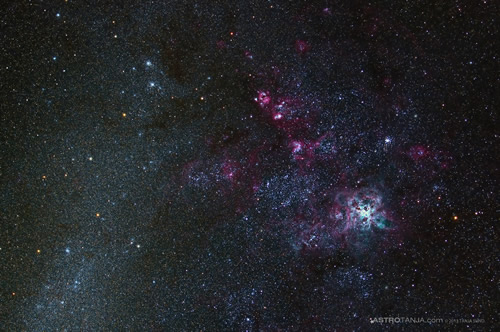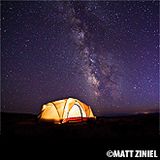
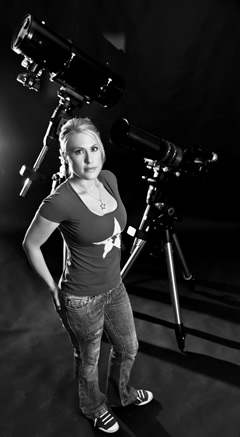
Known to the online world as "AstroTanja," 34-year-old Tanja Sund of South Africa is a magazine editor by day, and a devoted astrophotographer by night. Oh, and she's also the mother of a 2-year-old daughter.
Though Sund admits to a "continual state of sleep deprivation," her images and blog have begun to impress a worldwide audience, and she shows no signs of slowing down. Sund counts an 8" Orion Astrograph and Autoguider among her gear, a fact that makes us immensely proud. Here is our interview of Tanja Sund, South Africa's hottest new Astrophotographer:
Orion: As publisher and editor of Fitness Magazine, SA, how was it that you got into astrophotography, and has it really been only 20 months since you started shooting the night sky?
AstroTanja: I've always been interested in science and astronomy, and yes, it's been 20 months since I first started imaging. I became a publisher in an industry that I'm passionate about, the fitness industry, due to my background in art, design and entrepreneurship. Starting the business just over 10 years ago now allows me a lot more freedom to chase my other passion, astrophotography.
Orion: What was the first night sky image you shot, and were you happy with it?
AstroTanja: First image I ever shot was the Orion Nebula, M42. At the time I was ecstatic, just to be able to capture something in the sky that's unseen to the naked eye. As first images go, it wasn't anything spectacular, but it got me absolutely hooked.
Orion: What are your favorite objects to image these days?
AstroTanja: Nebulae most definitely. The colors and structures fascinate me, and they all look different - each with its own challenges.
Orion: Have you noticed that there are very few women in the astronomy and astrophotography field, or is that not the case in the southern hemisphere?
AstroTanja: Yes, there aren't many women in the astrophotography field. I think it's mostly due to science and astronomy not being such a highlight for a lot of women, but also because it's quite technical and potentially physically strenuous (well my setup is anyway). There are imaging couples, and women mainly stick to post-processing rather than image acquisition, however I take pride in every aspect of my imaging. From packing up the scope, transporting, setting up, acquisition to post editing. I'm proud of my images because I know what went into capturing them, from start to finish. This statement is more of a generalization, but I think most ladies would rather spend an evening relaxing (or shopping) than being out in the dark all night.
Orion: What is the greatest lesson you've learned through your work?
AstroTanja: To put proper focus and time into setting up, prepping for an imaging session, and to be extremely precise with polar alignment. Don't overlook the small things - they make for a better end result.
Orion: How dark are the skies over Johannesburg, and is that where you do most of your imaging?
AstroTanja: Jozi is the most light polluted spot in Africa. That said, it's not impossible to image here. Having the right equipment and shooting shorter exposures, but many, many, more of them help increase SNR. I'm switching to narrowband imaging soon, so the light pollution won't bother me. But for the most part, I try and get away to image. My favorite spot is a 2400km round trip drive, Sutherland in the Northern Cape. It's a truly dark sky there. Sutherland is the home of SALT (South African Large Telescope)
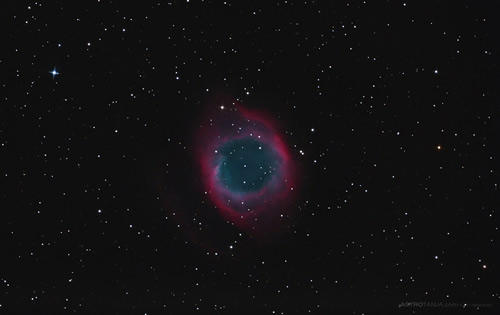
Helix Nebula. Credit: AstroTanja. Shot with a 10" Orion Astrograph. Full blog post about capturing this image here.
Orion: Any must have equipment?
AstroTanja: A must have for superior images, is a guide scope/cam. Post editing software has come a long way to bridge the gap between average and superb optics, yet everything is irrelevant if you can't have long exposures and round stars. Even with excellent polar alignment you're not going to be able to get a 5min exposure on an entry level/average mount. I currently use the Orion's SSAG, (Star Shoot Auto Guider). It's easy to use, cost effective and works wonderfully with PHD Guiding and my Celestron mounts.
Orion: Has observing and astrophotography changed your life or sense of self in any way? If so, how?
AstroTanja: It's changed everything in my life. It's a challenging form of photography and I'm always striving to better myself. I'm indeed slightly obsessed with improving my images, and I'll chase dark skies all over the world to photograph the sky. It's awakened my sense of adventure and I see imaging opportunities as a way to explore the world. Whether it's driving 12 hours to get to a dark sky in South Africa, flying to the USA with my APO to image the northern sky, or getting to Iceland to capture some aurora - it's all a big adventure. Furthermore, astrophotography is the reason I found that one person I couldn't live without - this shared passion for photographing the sky brought Cory (@TheAstroShake) and I together.
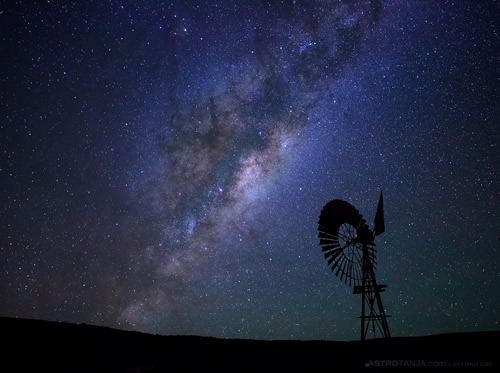
Our galactic core as it rises over the desert landscape of the Karoo, South Africa (Sutherland). Credit: AstroTanja
Orion: Have you been to the northern hemisphere to image yet? I'm very interested on your take on how the skies differ between the northern and southern hemispheres.
AstroTanja: Yes. In September I traveled to the USA to photograph the Andromeda galaxy and a few other northern targets. And in November I traveled to Iceland to photograph Aurora. It's slightly disorientating seeing objects rotate counter-clockwise around the celestial pole (in the south they go clockwise around the SCP), but it's great to see a few of the constellations I never see from where I live.
Orion: For us northern hemisphere observers hoping to travel, can you recommend some top targets to look for in the southern hemisphere?
AstroTanja: Top Southern Hemisphere targets are Omega Centauri, the largest globular cluster in the Milky Way Galaxy. Tarantula Nebula - NGC 2070, the most active starburst region known in the Local Group of galaxies, located on the rim of the large Magellanic cloud in the constellation of Dorado. The Small and Large Magellanic Clouds - as satellites of our Milky Way, these magnificent southern objects are only about 180,000 light years away, 15 times closer than the Andromeda Galaxy, M31. The Milky Way core overhead - the southern skies get a spectacular Milky Way core right overhead in our winter months. The Carina Nabula, one of the largest diffuse nebulae in our skies. Although it is some four times as large and even brighter than the famous Orion Nebula, the Carina Nebula is much less well known, due to its location far in the Southern Hemisphere. And finally, the Southern Cross and the Coalsack Dark Nebula. The Coalsack Dark Nebula is easily visible with the naked eye as a dark nebula in southern skies, in the constellation Crux.
I'll say Carina and Tarantula are probably two of the favorites with imagers as they carry more nebulosity and structure.
Orion: What would be your dream astrophotography trip?
AstroTanja: Any place dark, really dark - that's about it.... In both hemispheres. Oh - and I'd like to do star trails on the equator.
Orion: Any last words of wisdom for aspiring astrophotographers?
AstroTanja: Attaining great images requires dedication. Acquisition and processing isn't an easy feat. Persist - and you'll get great results. Don't always blame your optics, I've seen superb images come from mediocre equipment.
Keep up with AstroTanja on twitter (@astrotanja) and on her blog, Astrotanja.com, and on Flickr.
Maria Grusauskas is the Community Editor at Orion Telescopes & Binoculars and a freelance writer in Santa Cruz, California. A beginner in the hobby, Maria has fallen in love with stargazing and astronomy, and looks forward to imaging and sketching her observations.




